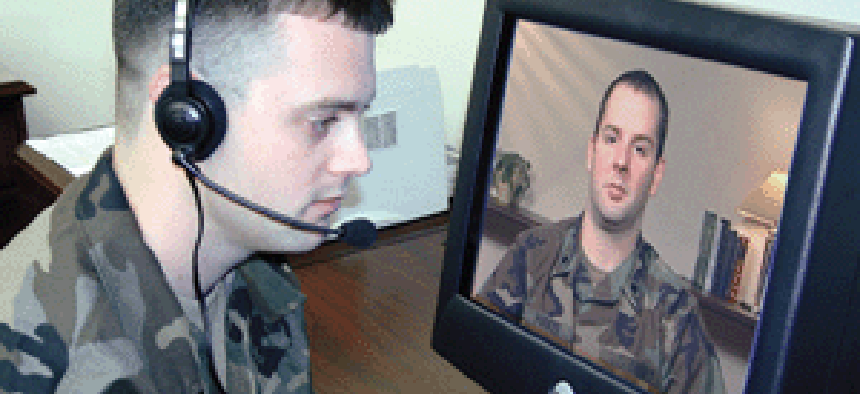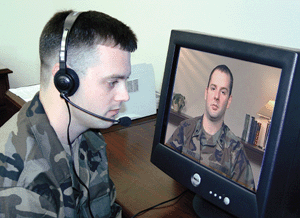E-learning technology gets smart

Certain government employees have been getting a healthy dose of bad attitude -- from a bunch of computers.
Certain government employees have been getting a healthy dose of bad attitude -- from a bunch of computers. Computer-simulated men and women are talking back to trainees at the FBI, the Bureau of Customs and Border Protection and other agencies to help them improve their interviewing techniques.If Mike Simmen, a simulated embezzler, doesn't like the line of questioning from an FBI trainee, he may get defensive and clam up.Advanced simulations are a new type of smarter e-learning systems gaining popularity in the government market. These technologies have been a long time coming, often funded by the military. But lower costs, easier-to-use development tools and potentially higher returns in the form of better worker productivity have made smart e-learning technology attractive to a wider variety of government agencies.Today's e-learning programs interact with students, learn about them and even hold their hands, at least metaphorically, when they perform daily computer operations. It's part of a "learn by doing" approach to e-learning that companies insist will improve the rate at which students retain the information they receive. According to an August 2000 study by Forrester Research, students retain 80 percent of what they learn when they actually do what they're being taught. Merely watching or listening to a lesson results in retention of 20 percent to 35 percent."If you think about the way people learned to ride a bicycle, they didn't do it by reading a book," said Bjorn Billhardt, chief executive officer at Enspire Learning Inc., an Austin, Texas-based developer of interactive e-learning programs.E-LEARNING THROUGH SIMULATIONThe Johns Hopkins University Applied Physics Laboratory in Laurel, Md., developed the Mike Simmen simulation the FBI used. Today, Mike Simmen and other simulations are sold by Columbia, Md.-based SIMmersion LLC, which licenses technology from the APL."Traditional e-learning suffered from a boring factor," said SIMmersion CEO Dale Olsen. "To get retention rates up, students had to be engaged."SIMmersion's simulations are built using the expressions and body movements of live actors. Their responses to different situations were captured and programmed into the software. The trainee uses earphones and a microphone to interact with the simulation and, depending on what the trainee says, the simulation will react a certain way."The character is always different," Olsen said. "You'll never have the same discussion twice."The Marine Corps uses SIMmersion technology to teach recruiters how to assess a potential recruit and persuade the person to join. The customs bureau uses SIMmersion simulations to teach agents how to identify smugglers or terrorists by the subtle clues they might give during questioning."The expansion of advanced simulation beyond traditional military purposes is a significant step in the evolution of e-learning," said Michael Brennan, program manager for corporate learning and performance at Framingham, Mass.-based research firm IDC. "By taking the end user through the steps of an actual situation, there's a better chance the student will learn from the process."COMPUTERS AS ONE-ON-ONE TUTORSStudents aren't the only ones learning. Developers found that if the training software itself could learn about a student over the course of a lesson, it could better determine which concepts, if any, were confusing the student and why.San Mateo, Calif.-based Stottler Henke Associates Inc. develops intelligent tutoring systems (ITS) for the government. Through artificial intelligence, ITS technology attempts to emulate the one-on-one interaction a student gets from an instructor by analyzing the student's actions and offering help that's tailored to that person's level of understanding. The theory is two students may get the same wrong answer during an e-learning course, but the reasons for their mistakes may be unique and require different courses of teaching.At the Surface Warfare Officers School, the Navy trained tactical action officers using Stottler Henke's ITS technology. The software would monitor a student's progress during tactical simulations and look for patterns of actions and reactions to identify more than just what the student did right and wrong."The system tries to identify the underlying problem or missing knowledge the student might have," said James Ong, technical group manager at Stottler Henke. "Over the long run, the ITS system gets smarter in what it knows about the student."Recently, Stottler Henke took another ITS technology it developed for the Navy and incorporated it into an adult literacy program called ReadOn. The Navy found that the reading skills of some recruits didn't meet its requirements, so Stottler Henke built an ITS program that diagnosed students' abilities and tailored lessons to their proficiency levels. Now, those advanced e-learning lessons can be used by any organization that needs to improve the literacy of its workers.ON-THE-JOB E-LEARNINGNot all intelligent e-learning takes place in simulators and online classrooms. Sometimes training has to take place at the exact moment when a worker needs the information. Embedded workflow training typically involves enterprise applications. If a worker can't figure out how to perform a certain task in a computer program, he can call on the embedded trainer to guide him through the process.As part of a $39 million enterprise software overhaul, the Washington Metropolitan Area Transit Authority adopted a technology called OnDemand Personal Navigator from King of Prussia, Pa.-based Knowledge Products to help employees learn the organization's various applications. Clicking on a link within the software brings up a window that offers both written and visual instructions for completing a task."It will show them exactly how to perform a function, and it's always available," said Rod Burfield, department assistant general manager for planning and strategic programs."Computer-based training ... is often delivered at a very different time from when the student is going to need the information," said Donald Spector, Knowledge Products' chief technical officer. The more immediate the training, the more likely the person is to put the knowledge to work, he said.Putting knowledge to effective use is the goal of all these intelligent e-learning technologies. Whether it's a simulation or embedded workflow trainer, the best e-learning products emphasize what researcher Sam Adkins called the "learning transfer" portion of training. "Knowledge transfer is the transmission of information to the worker," Adkins said. "Learning transfer comes when they transfer knowledge to the job." Staff Writer Brad Grimes can be reached at bgrimes@postnewsweektech.com.
 Cheaper, easier-to-use tools draw attention of government
Cheaper, easier-to-use tools draw attention of government

With SIMmersion computer simulations, government employees can practice interpersonal skills. The simulation is programmed to react to what the trainee says.
SIMmersion LLC
NEXT STORY: HEAD OF THE CLASS